Fogo, Cape Verde
Fogo (Portuguese pronunciation: [ˈfoɡu]; Portuguese for "fire") is an island in the Sotavento group of Cape Verde. Its population is 35,837 (2015),[1]: 36 with an area of 476 km2.[1]: 25 It reaches the highest altitude of all the islands in Cape Verde, rising to 2,829 metres (9,281 feet) above sea level at the summit of its active volcano, Pico do Fogo.[1]: 25
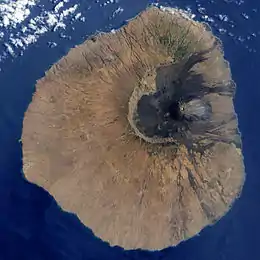 Natural colour satellite image of Fogo | |
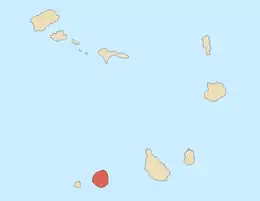 | |
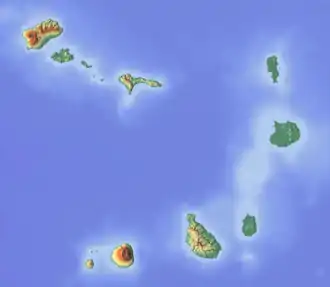 Fogo 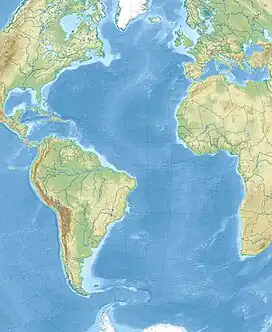 Fogo | |
| Geography | |
|---|---|
| Location | Atlantic Ocean |
| Coordinates | 14.9500°N 24.3425°W |
| Area | 476 km2 (184 sq mi) |
| Length | 26.3 km (16.34 mi) |
| Width | 23.9 km (14.85 mi) |
| Highest elevation | 2,829 m (9281 ft) |
| Highest point | Pico do Fogo |
| Administration | |
| Concelhos (Municipalities) | Mosteiros, Santa Catarina do Fogo, São Filipe |
| Largest settlement | São Filipe (pop. Sao Filipe) |
| Demographics | |
| Population | 45,837 (2015) |
| Pop. density | 75.3/km2 (195/sq mi) |
History
The eastern side of Fogo collapsed into the ocean 73,000 years ago, creating a tsunami 170 meters high which struck the nearby island of Santiago.[2]
Fogo was discovered in 1460 by Genovese captain António de Noli on behalf of Henry the Navigator and the Portuguese Crown. It appeared in a 1598 map as I. de Fogo.[3] Fogo was the second island of Cape Verde that was settled by the Portuguese, between 1470 and 1490, making São Filipe the second oldest town of Cape Verde after Cidade Velha.[4]
The Fogo volcano erupted frequently, both from the summit and from flank fissures,[5] notably in 1680, 1725, 1857, 1951, 1995, and 2014–15.[6] The eruption of 1680 covered much of the island in ash, which forced many inhabitants to flee to the nearby island of Brava.[6]
Fogo has been very susceptible to drought and famine. In years that the rains during the summer months were insufficient, many inhabitants were menaced by starvation. This occurred several times in the 18th and 19th century, and also between 1941 and 1943, when 31% of the island population perished.[7]
Until January 1992 the island was one single municipality, subdivided into four parishes. The southwestern three parishes joined the new municipality of São Filipe and the northeastern parish Nossa Senhora da Ajuda became the municipality of Mosteiros.[8][9] The parish of Santa Catarina do Fogo was separated from São Filipe in 2005, and became the Municipality of Santa Catarina do Fogo.[10]
Geography
One of the southernmost islands in Cape Verde, Fogo is located between the islands of Santiago to the east and Brava to the west. It is 26.3 km long and 23.9 km wide; its area is 476 km2.[1]: 25 Practically the whole island is a stratovolcano that has been periodically active: it last erupted in 2014. The largest volcanic feature is Bordeira, a nine-kilometre-wide (5.6 mi) caldera, which has walls one kilometre (0.62 miles) high, and has a breach in its eastern rim.[6] Two small villages, Portela and Bangaeira, exist in the floor of the caldera (Chã das Caldeiras); the residents were evacuated during eruptions.
The island's main city is São Filipe, near which are an airport and a port. Fogo is largely an agricultural, fertile island. The north-eastern part receives the most precipitation.
Flora and fauna
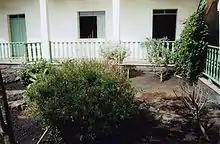
Key bird species of Fogo are Fea's petrel, Boyd's shearwater and Cape Verde swift.[11] The endemic plants Echium vulcanorum (endangered)[12] and Erysimum caboverdeanum (critically endangered)[13] are only found on the outer crater rim of the volcano of Fogo.[11]
Climate
Being very mountainous, Fogo has quite a number of climates. Along the coast Fogo has a moderate dry tropical climate according to the Köppen–Geiger climate classification system; higher on the slopes (~ 800 metres or 2,600 feet A.S.L.) it has a semiarid mild tropical climate (Köppen–Geiger BSh with very balanced temperatures year round; above 1,000 metres (3,300 feet) it has a cool highland subtropical steppe climate (Köppen–Geiger BSkL). The average annual temperature on the coast is about 23–25 °C (73–77 °F), decreasing to some 12–14 °C (54–57 °F) on the highest ground.
There can be remarkably cool weather in the interior, with the warmer wet season starting in July and ending in November, with the colder dry season starting in December and ending in May. Drought, the major climate risk of Cape Verdean islands, is much less pronounced on Fogo, due to the mountain's ability to gain moisture from clouds. During the mid-nineteenth century, Fogo suffered from severe droughts. Death from starvation was common in the 1830s.[14]
| Climate data for São Filipe, southwestern Fogo, 113 metres (371 feet) ASL | |||||||||||||
|---|---|---|---|---|---|---|---|---|---|---|---|---|---|
| Month | Jan | Feb | Mar | Apr | May | Jun | Jul | Aug | Sep | Oct | Nov | Dec | Year |
| Average high °C (°F) | 25.6 (78.1) |
25.6 (78.1) |
26.2 (79.2) |
26.7 (80.1) |
27.1 (80.8) |
27.8 (82.0) |
28.4 (83.1) |
28.7 (83.7) |
29.1 (84.4) |
29.0 (84.2) |
28.6 (83.5) |
26.4 (79.5) |
27.4 (81.3) |
| Daily mean °C (°F) | 22.3 (72.1) |
22.1 (71.8) |
22.6 (72.7) |
23.0 (73.4) |
23.7 (74.7) |
24.3 (75.7) |
25.1 (77.2) |
25.7 (78.3) |
26.2 (79.2) |
26.3 (79.3) |
25.2 (77.4) |
23.5 (74.3) |
24.2 (75.6) |
| Average low °C (°F) | 19.1 (66.4) |
18.7 (65.7) |
19.0 (66.2) |
19.4 (66.9) |
20.3 (68.5) |
20.8 (69.4) |
21.8 (71.2) |
22.8 (73.0) |
23.3 (73.9) |
23.7 (74.7) |
21.9 (71.4) |
20.6 (69.1) |
21.0 (69.8) |
| Average rainfall mm (inches) | 3 (0.1) |
2 (0.1) |
0 (0) |
0 (0) |
0 (0) |
0 (0) |
14 (0.6) |
81 (3.2) |
121 (4.8) |
35 (1.4) |
11 (0.4) |
5 (0.2) |
272 (10.8) |
| Source: Climate-Data.ORG[15] | |||||||||||||
| Climate data for Chã das Caldeiras, central Fogo, 1,764 metres (5,787 feet) ASL | |||||||||||||
|---|---|---|---|---|---|---|---|---|---|---|---|---|---|
| Month | Jan | Feb | Mar | Apr | May | Jun | Jul | Aug | Sep | Oct | Nov | Dec | Year |
| Average high °C (°F) | 14.8 (58.6) |
14.9 (58.8) |
15.4 (59.7) |
15.9 (60.6) |
16.4 (61.5) |
17.1 (62.8) |
17.7 (63.9) |
18.3 (64.9) |
18.9 (66.0) |
18.4 (65.1) |
17.4 (63.3) |
15.4 (59.7) |
16.7 (62.1) |
| Daily mean °C (°F) | 11.7 (53.1) |
11.5 (52.7) |
11.8 (53.2) |
12.3 (54.1) |
13.1 (55.6) |
13.7 (56.7) |
14.5 (58.1) |
15.2 (59.4) |
15.6 (60.1) |
15.5 (59.9) |
14.2 (57.6) |
12.7 (54.9) |
13.5 (56.3) |
| Average low °C (°F) | 8.7 (47.7) |
8.2 (46.8) |
8.3 (46.9) |
8.8 (47.8) |
9.8 (49.6) |
10.4 (50.7) |
11.3 (52.3) |
12.2 (54.0) |
12.3 (54.1) |
12.6 (54.7) |
11.1 (52.0) |
10.1 (50.2) |
10.3 (50.5) |
| Average rainfall mm (inches) | 11 (0.4) |
6 (0.2) |
3 (0.1) |
0 (0) |
0 (0) |
2 (0.1) |
49 (1.9) |
151 (5.9) |
198 (7.8) |
67 (2.6) |
25 (1.0) |
12 (0.5) |
524 (20.5) |
| Source: Climate-Data.ORG[16] | |||||||||||||
Population
In the 1830s, Fogo had an estimated human population of 10,000.[14] In 2015, Fogo had 35,837 inhabitants, making it the fourth most populous island in the Cape Verde archipelago after Santiago, São Vicente and Santo Antão.[1]: 36 Since 2015, there are three cities (São Filipe, Mosteiros and Cova Figueira) and two towns (Ponta Verde and Patim) in the island.[1]: 32–33
| Population of Fogo, Cape Verde (1940–2015) | ||||||||
|---|---|---|---|---|---|---|---|---|
| 1940[17] | 1950[17] | 1960[17] | 1970[17] | 1980[17] | 1990[17] | 2000[17] | 2010[18] | 2015[1]: 36 |
| 23,022 | 17,582 | 25,615 | 29,412 | 30,978 | 33,902 | 37,409 | 37,071 | 35,837 |
The official language of Fogo is Portuguese; yet mostly Fogo Creole is spoken.
Economy
The economy of the island is based on agriculture and fishing, with coffee and wine among the main products. In the 1830s, Fogo's wine was described as being "very superior."[14] Due to its volcanic soil Fogo's coffee also has a good reputation.[19] The island has experienced a substantial diaspora. Many households live off remittances from emigrants in the U.S. and in European countries (Portugal, France, the Netherlands, Italy). Fogo fosters strong connections to Rhode Island and to Massachusetts (U.S.), where many people with Cape Verdean origin live.
Tourism is steadily becoming popular. The volcano (allowed only accompanied by a local guide) is the island's major attraction but many visitors also come to see relatives. The historic city of São Filipe and Chã das Caldeiras in the volcanic crater receive the bulk of visitors. No great tourism facilities exist, but there are small hotels and bed-and-breakfasts and local guides offer hiking tours.
Administrative divisions
The island is divided in three municipalities, which are subdivided into civil parishes:
Transportation
The island has a domestic airport, São Filipe Airport, located in the southwest of the island. There is a port at Vale de Cavaleiros near São Filipe, with ferry connections to the islands of Brava (Furna) and Santiago (Praia).[20] There are two first class national roads on Fogo: the Fogo Circular Road (EN1-FG01) and the road linking São Filipe and the island's port (EN1-FG02).[21]
Sports
The main football teams are Académica do Fogo, Botafogo, Cutelinho, Spartak d'Aguadinha and Vulcânicos.
Notable people
- Pedro Cardoso, poet
- Zé Luís, footballer
- Pedro Pires, first Prime Minister and 3rd President of Cape Verde
- Henrique Teixeira de Sousa, writer
- Carlos de Vasconcelos, politician and journalist
Gallery
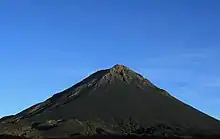 Main ash cone of Pico do Fogo
Main ash cone of Pico do Fogo 3-D image of the island of Fogo from NNE
3-D image of the island of Fogo from NNE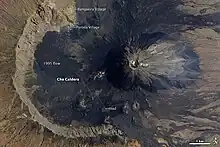 Chã das Caldeiras and main ash cone, Fogo. NASA satellite image, 2009
Chã das Caldeiras and main ash cone, Fogo. NASA satellite image, 2009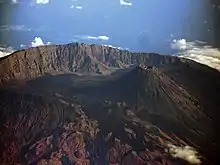 Aerial shot
Aerial shot Aerial shot
Aerial shot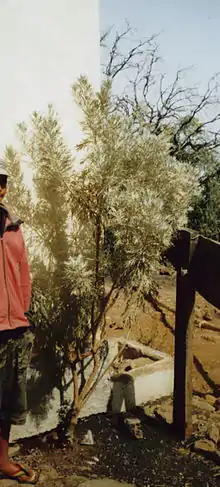 Losma, an endemic medicinal plant
Losma, an endemic medicinal plant
References
- Cabo Verde, Statistical Yearbook 2015, Instituto Nacional de Estatística
- Brown, Emma (2015). "Island boulders reveal ancient mega-tsunami". Nature. doi:10.1038/nature.2015.18485. S2CID 182938906. Retrieved 2015-10-06.
- "Insulae Capitis Viridis" (in Latin). 1598.
- Centre historique de São Filipe, UNESCO
- Carracedo, Juan-Carlos; Perez-Torrado, Francisco J.; Rodriguez-Gonzalez, Alejandro; Paris, Raphaël; Troll, Valentin R.; Barker, Abigail K. (July 2015). "Volcanic and structural evolution of Pico do Fogo, Cape Verde". Geology Today. 31 (4): 146–152. doi:10.1111/gto.12101.
- S. F. Jenkins; et al. (20 March 2017). "Damage from lava flows: insights from the 2014–2015 eruption of Fogo, Cape Verde". Journal of Applied Volcanology. 6. doi:10.1186/s13617-017-0057-6. S2CID 55153991.
- Cape Verde History Timeline, WorldAtlas
- History of Mosteiros (in Portuguese)
- Lei nº 23/IV/91, p. 43
- Lei nº 66/VI/2005, p. 52
- "Volcano area, Ilha do Fogo". Important Bird Areas factsheet. BirdLife International. 2018. Retrieved 2018-08-07.
- Catarino, S.; Duarte, M.C.; Romeiras, M.M. (2017). "Echium vulcanorum". IUCN Red List of Threatened Species. 2017: e.T107425957A107468177. doi:10.2305/IUCN.UK.2017-3.RLTS.T107425957A107468177.en. Retrieved 19 November 2021.
- Catarino, S.; Duarte, M.C.; Romeiras, M.M. (2017). "Erysimum caboverdeanum". IUCN Red List of Threatened Species. 2017: e.T107426112A107468187. doi:10.2305/IUCN.UK.2017-3.RLTS.T107426112A107468187.en. Retrieved 12 November 2021.
- Roberts, Edmund (1837). Embassy to the Eastern Courts of Cochin-China, Siam, and Muscat. New York: Harper & Brothers. p. 14.
- "Climate São Filipe". Retrieved 7 October 2018.
- "Climate Chã das Caldeiras". Retrieved 7 October 2018.
- Source: Statoids
- 2010 Census Summary
- Fogo coffee
- Cabo Verde Fast Ferry's website
- Ilha do Fogo, Rede rodoviária Archived 2018-08-15 at the Wayback Machine, Instituto de Estradas
External links
- Informations and impressions from Fogo
- Caboverde.com
- University of Massachusetts – information and images from Fogo
- Fogo people picture